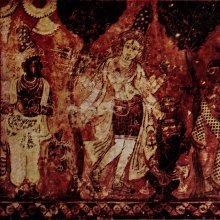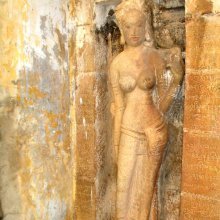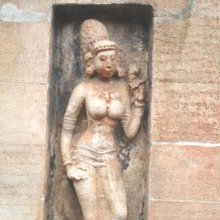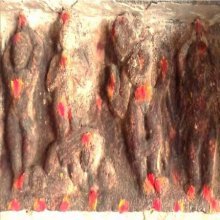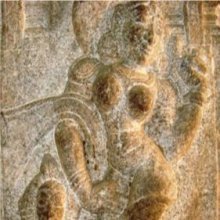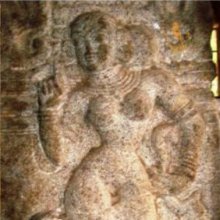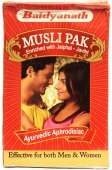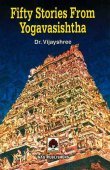Woman, Women: 3 definitions
Introduction:
Woman means something in Hinduism, Sanskrit. If you want to know the exact meaning, history, etymology or English translation of this term then check out the descriptions on this page. Add your comment or reference to a book if you want to contribute to this summary article.
Images (photo gallery)
(+60 more images available)
In Hinduism
Natyashastra (theatrics and dramaturgy)
Source: Shodhganga: Elements of Art and Architecture in the Trtiyakhanda of the Visnudharmottarapurana (natya)Women are associated with Mṛgaśīrṣa-hasta: one of the twenty-two Single-hand Gestures (in Indian Dramas) (known as asaṃyuktahastas), according to the Viṣṇudharmottarapurāṇa, an ancient Sanskrit text which (being encyclopedic in nature) deals with a variety of cultural topics such as arts, architecture, music, grammar and astronomy.—The word mṛgaśīrṣa is the union of two words viz., mṛga and śīrṣa. The word mṛga means deer and śīrṣa means head. So, it can be said that the hand posture which is called mṛgaśīrṣa identifies a posture that looks like the head of a deer. [...] In the Abhinayadarpaṇa, the mṛgaśīrṣa-hasta posture is used to denote various things. This book states that this posture is used to show woman, cheek, wheel, limit, terror, quarrel, attire and to call someone or the beloved, the lute, foot massage, female organ, holding umbrella etc.

Natyashastra (नाट्यशास्त्र, nāṭyaśāstra) refers to both the ancient Indian tradition (shastra) of performing arts, (natya—theatrics, drama, dance, music), as well as the name of a Sanskrit work dealing with these subjects. It also teaches the rules for composing Dramatic plays (nataka), construction and performance of Theater, and Poetic works (kavya).
Shilpashastra (iconography)
Source: Shodhganga: Elements of Art and Architecture in the Trtiyakhanda of the Visnudharmottarapurana (shilpa)Women are classified into five kinds which are defined according to the principles of ancient Indian Painting (citra), according to the Viṣṇudharmottarapurāṇa, an ancient Sanskrit text which (being encyclopedic in nature) deals with a variety of cultural topics such as arts, architecture, music, grammar and astronomy.—In the third part of the Viṣṇudharmottarapurāṇa, nine chapters i.e., chapters from 35th to 43rd are dedicated to Painting where portraits of different kinds of men and women. According to the Viṣṇudharmottarapurāṇa there are five types of women and the divisions of women follow the varieties of men. In the 37th chapter of the Viṣṇudharmottarapurāṇa it is said that-each woman should be placed near her man,[41] which indicates that the names of the variety of the women may be equated with the concerned varieties of men.

Shilpashastra (शिल्पशास्त्र, śilpaśāstra) represents the ancient Indian science (shastra) of creative arts (shilpa) such as sculpture, iconography and painting. Closely related to Vastushastra (architecture), they often share the same literature.
Yoga (school of philosophy)
Source: ORA: Amanaska (king of all yogas): A Critical Edition and Annotated Translation by Jason BirchWomen commonly practiced Yoga in ancient India, as evident from the Yogayājñvalkya 6.12, 16-6.19ab.—Also, the Yogayājñvalkya prescribes the study of the Upaniṣads for Brahmins and Kṣatriyas, and the Purāṇas for Vaiśyas, Śūdras and women. Though it has a Vedic and Vaiṣṇava orientation that is absent in the Amanaska and though the Amanaska has not one reference to a female yoga practitioner, it is certainly possible that the Amanaska permitted all four castes and women to practise Yoga as in the Yogayājñvalkya, for the former has a stronger universalist flavour than the latter.
Two later commentators, namely the early sixteenth-century Godāvaramiśra and the seventeenth-century Śivānandasarasvatī, quote a verse from Śivānanda’s Yogacintāmaṇi (p. 57), which includes women among those who can benefit from Yoga. [...] Though Godāvaramiśra and Śivānanda quote the verse without attribution, it probably originates from the Viṣṇudharma (98.16), because there it occurs in a chapter on yoga in a context for which it seems to have been written.

Yoga is originally considered a branch of Hindu philosophy (astika), but both ancient and modern Yoga combine the physical, mental and spiritual. Yoga teaches various physical techniques also known as āsanas (postures), used for various purposes (eg., meditation, contemplation, relaxation).
See also (Relevant definitions)
Starts with: Woman drake, Woman-piaba.
Query error!
Full-text (+12884): Stri, Sauvida, Suvida, Mahila, Sthapatya, Yuvati, Nari, Striratna, Lalana, Angana, Straina, Vaṇita, Bhagini, Ratrihindaka, Pramada, Kancukin, Nivi, Stridharma, Rakshapekshaka, Sthapati.
Relevant text
Search found 557 books and stories containing Woman, The woman, The women, Women; (plurals include: Womans, The womans, The womens, Womens). You can also click to the full overview containing English textual excerpts. Below are direct links for the most relevant articles:
A Discourse on Paticcasamuppada (by Venerable Mahasi Sayadaw)
Chapter 7 - The Story Of Mahatissa Thera < [Part 6]
Chapter 1 - Tanha Causes Upadana < [Part 7]
Chapter 8 - Story Of A Parrot < [Part 6]
History of Indian Medicine (and Ayurveda) (by Shree Gulabkunverba Ayurvedic Society)
Chapter 10 - Woman in Caraka’s Times < [Part 4 - Some Aspects of Life in Caraka’s Times]
Chapter 19 - Nursing < [Part 2-3 - Medical Institutions in Ancient India]
Chapter 12 - Examination, Registration and Convocation < [Part 2-3 - Medical Institutions in Ancient India]
The Bhikkhus Rules (by Bhikkhu Ariyesako)
World Journal of Pharmaceutical Research
Effect of epidural analgesia on mode of delivery and perinatal outcome < [2017: Volume 6, October special issue 13]
Ayurveda prespective for the management of womens lifestyle disorder < [2022: Volume 11, October special issue 14]
Issues related to nutrition in pregnenat women < [2019: Volume 8, July issue 8]
Vipassana Meditation (by Chanmyay Sayadaw)
Part 5 - Seven Benefits Of Meditation < [Chapter 3 - Seven Benefits Of Mindfulness Meditation]
Part 4 - Purification By Overcoming Doubt < [Chapter 5 - The Seven Stages Of Purification]
Part 2 - Attta In Buddhism < [Chapter 7 - The Five Factors Of A Meditator]
Kamashastra Discourse (Life in Ancient India) (by Nidheesh Kannan B.)
4.1. Summary of Kāma-sūtra Book 5: Pāradārika < [Chapter 3 - A Thematic Analysis of Vātsyāyanakāmasūtra]
4.1. Summary of Kāma-sūtra Book 2: Sāmprayogika < [Chapter 3 - A Thematic Analysis of Vātsyāyanakāmasūtra]
4.1. Summary of Kāma-sūtra Book 3: Kanyā-samprayuktaka < [Chapter 3 - A Thematic Analysis of Vātsyāyanakāmasūtra]
Related products
(+59 more products available)
